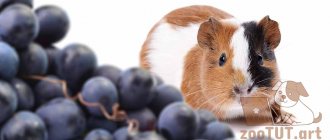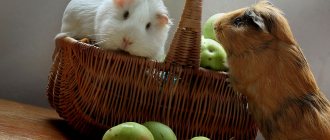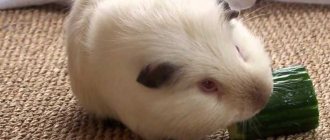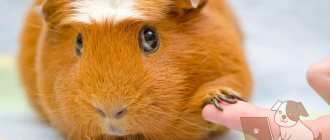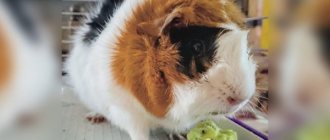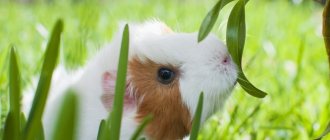- home
- Guinea pig
- Guinea pig nutrition
02/06/2019 You should not give guinea pigs the same things that other pets or the owners themselves eat. In nature, these animals constantly find new types of food and, at the level of instincts, determine their edibility and safety. At home, the pig eats monotonously, its instincts are dulled, and it eats dangerous indoor plants, found pieces of food, and what an uninformed owner offers it. The owner’s task is to protect the pet from dangerous food.
Can guinea pigs have a shepherd's purse?
Shepherd's purse (Capsella bursa-pastoris) Has anti-inflammatory and diuretic effects, inhibits the development of cancer tumors. This plant should never be given to pregnant pigs because it causes uterine contractions.
Interesting materials:
How to make a colored background in Photoshop? How to make a color gradient in Photoshop? How to make a colored circle in Photoshop? How to make a colored circle on Instagram? How to make a color prefix in Minecraft? How to make colored rice? How to make colored text in Illustrator? How to make colored text in Minecraft on PC? How to make a colored bed in Minecraft? How to make a colored frame in Photoshop?
Vegetables
It is necessary to include fresh vegetables in the pigs' diet - they improve digestion and contain vitamins and other beneficial substances. However, not all vegetables have a beneficial effect on the animals’ bodies. Some are dangerous and can cause severe harm to their health.
Prohibited products include:
- Potatoes (tubers and tops): due to the large amount of starch;
- onions (including green and leeks) and garlic;
- radish: sharp taste causes irritation of the mucous membrane;
- Rhubarb: contains oxalic acid, which is harmful to the stomach.
All of these vegetables are harmful even in small quantities, so they should be kept away from your pet.
Feeding cabbage (white and red, Brussels sprouts) is undesirable. In large quantities it causes diarrhea and flatulence. Various legume products cause bloating. Along with radishes and radishes, hot peppers are prohibited.
What other foods are contraindicated for pigs?
What is not poisonous to humans can be destructive to the delicate body of a guinea pig.
Products that should be included in the diet in very small quantities:
- hazelnut;
- Walnut;
- seeds (sunflower, pumpkin, dill, sesame).
Sweets should never be given to a rodent. Candies, chocolate, marshmallows, halva are heavy foods that will lead to poisoning. Even the smallest amount of chocolate acts as a strong poison on the pig’s body.
You should not tempt fate and give the animal exotic fruits, no matter how much he begs for them. The pig is not given baked goods (including crackers, bagels), cookies, boiled porridge, soups and borscht in any form. The digestive system of these animals is not adapted to thermally processed foods.
Fruits
The main criteria when choosing fruit treats for pigs are:
- As little sugar as possible.
- A decisive “no” to sour foods.
- Use only ripe and fresh fruits.
Before giving fruit to animals, they are washed, scalded with boiling water, cut into small pieces, and the seeds are removed. It is advisable not to determine the amount of treats by eye; it is better to consult with a veterinarian about how much fruit you can give to a particular animal.
Table 4. How often can fruit be added to the rodent menu.
| 4–5 times a week | 1–2 times a week | 1 time per month |
| Apple, pear. | Banana, persimmon, orange, tangerine. | Pineapple, mango, kiwi, grapes, guava. |
Important! It is forbidden to give lemon to guinea pigs.
Fruits are a healthy part of a guinea pig's diet. These products diversify the diet and compensate for the lack of essential minerals and amino acids. However, moderation in the amount of treats should be observed. This is necessary to protect pigs from the development of allergic reactions and gastrointestinal disorders.
Important! Under no circumstances should guinea pigs be given citrus fruit zest or banana peels.
Feeding recommendations
The pet needs to be fed correctly so that its health remains normal, its teeth are strong, and its coat looks well-groomed. Your pet's daily menu should include:
- 50% hay; 20% dry food; 20% juicy food; 10% greens.
An important question for owners is how many times a day to give food to a guinea pig. Feeding is carried out 3 times a day. The feeder cannot be removed from the cage; food must always be available to the animal. There should also always be hay in the cage.
If there is no dry food in the animal’s diet, then it must be replaced with a similar weight of greens and raw vegetables. The menu should be varied; the rodent must be offered at least three different vegetables per day and certainly grass. It is prohibited to give your pet grass collected on the sides of highways and in industrial areas.
The optimal menu is vegetables and fruits before noon, dry food after noon.
Other
Among other things, it is worth mentioning that guinea pigs do not tolerate processed foods: fried, boiled, pickled, baked, canned. The owner must not feed the pet food from his table. Including sweets: chocolate, marshmallows, cookies, etc.
Other prohibited products include:
- mushrooms;
- sauces - ketchup, mustard, etc.;
- sorrel;
- plantain.
There are special sweets for rodents - drops. They come in different flavors - berry, citrus, vegetable. Pets really like them, they should be used carefully and offered occasionally, like regular fruits. Drops contain sugar, which is harmful to animals.
Before offering your pet something tasty, you should check the list of prohibited foods. If there is no information on a specific product, the best option is to put it aside and choose something else.
Its well-being and life expectancy depend on the proper organization of a guinea pig’s daily diet. There is a list of foods that should not be given to guinea pigs under any circumstances. Pet owners should know about this so as not to make a fatal mistake.
Nutrition for pregnant pigs and newborn piglets
Pregnant pets must eat well and of high quality. The diet of furry mothers should be rich in proteins and vitamins. It is useful to give pregnant females carrots, beets, and wheat sprouts. You can periodically add a little milk to the water. Rosehip infusion brings great benefits to the body of a pregnant pig.
If the female who gave birth does not have milk, then the owner will have to feed the cubs on his own using a syringe. Artificial food for small piglets includes low-fat cream and the probiotic Linex. The cream is taken into the syringe and a tenth of the probiotic capsule is added to it. The resulting solution is nutritious and beneficial for the digestive system of babies. The food in the syringe is warmed to room temperature. Piglets take 1 ml of food every hour. Two-week-old babies can be switched to cereal porridge without milk. The piglets sit on the porridge until they get used to “adult” food.
What is harmful for pigs?
Below we provide a list of foods, most of which are harmless in small quantities and do not contain many nutrients. And if you consume a large amount of such products, your pet may experience health problems.
Vegetables
Cabbage, namely white cabbage, Brussels sprouts and red cabbage. If you overfeed this product, your animal may experience severe flatulence and diarrhea.
Bulbs (green onions, leeks) are poisonous to guinea pigs.
Legumes can cause bloating in rodents, and in large quantities these products are toxic to pigs. But you can offer your pet some raw and fresh sprouts.
Potato. The tubers contain a large amount of starch, which is poorly digestible in its raw form, and the tops are poisonous.
Radishes and radishes have a strong taste and can cause irritation to the mucous membranes, so they are undesirable for these rodents.
Rhubarb contains a large amount of oxalic acid, which is poisonous for pigs.
Stone fruits - peaches, cherries, apricots, and plums contain large amounts of sugar and consuming them in large quantities can cause severe diarrhea.
You should also not feed your pet exotic fruits, as this will lead to digestive upset for the animal.
Animal products
Products of animal origin are contraindicated - milk, cottage cheese, butter, cream, meat, eggs, fish - since guinea pigs are vegetarians and do not eat such foods in their natural habitat.
Herbs
Some herbs are strictly contraindicated for guinea pigs, as they can lead to poisoning and even death of the animal. These herbs include:
- nightshade,
- dope,
- St. John's wort,
- belladonna,
- celandine,
- wolf berries,
- spurge,
- hemlock,
- night blindness,
- poppy,
- lily of the valley,
- henbane,
- marsh marigold,
- fighter,
- anemone,
- digitalis,
- veh poisonous,
- mustard,
- lumbago,
- hellebore,
- calligraphy,
- larkspur,
- buttercups,
- wild rosemary,
- wild and field radish,
- Avran officinalis,
- autumn colchicum,
- Kukol and others.
If you doubt what species a plant belongs to, then you should not risk the health or even the life of your pet; do not give it an unknown type of grass.
Indoor flowers
If you have a lot of flowers at home, then read the list of indoor plants that are poisonous to guinea pigs and put them away so that the animal does not get to them.
Poisonous indoor flowers for guinea pigs:
- cyclamen,
- anthurium,
- azalea,
- all types of milkweed,
- ivy,
- fatsia,
- Schefflera,
- alocasia,
- dieffenbachia,
- calla,
- zamioculcas,
- monstera,
- syngonium,
- spathiphyllum,
- caladium,
- philodendron,
- scindapsus,
- clivia,
- hippeastrum,
- oleander,
- nightshade,
- croton,
- asparagus,
- aloe,
- jasmine,
- ficus and others.
As you can see, most popular houseplants are poisonous to pets, so always make sure your pet doesn't accidentally eat any of the leaves growing on the windowsill.
Other
You should not feed your guinea pig sugar, chocolate, candy, honey, ice cream, cookies, marshmallows, marmalade and other sweets. Table salt in its pure form is not suitable for a rodent; it is better to offer your guinea pig a mineral or salt stone.
Also contraindicated for consumption are baked goods (bread, rolls, etc.), fried, salted, pickled, smoked, as well as boiled and baked products.
Branches, leaves and fruits of cypress, buckthorn, thuja, robinia, and yew are poisonous to guinea pigs.
Walnut branches can be given with leaves, but rarely, and the nuts themselves cannot be given. The situation is the same with chestnuts - branches can be offered to your pet occasionally, but chestnuts should never be given, they contain tannin.
But regarding oak, opinions differ - some believe that the branches of this tree should absolutely not be given to pigs, while others believe that it is possible, but rarely and in small quantities. But these rodents definitely can’t eat acorns because of the tannin they contain.
Also, you should not feed your guinea pig mushrooms, onions, garlic, sorrel, spinach, horseradish, salad mustard, raw or boiled cereals. Store-bought watermelons, cucumbers, herbs and tomatoes should not be used as pet food.
Regarding citrus fruits, there is an opinion that they can be given, but in very small quantities. Oranges, tangerines and grapefruits are peeled and filmed and given to the animals. Guinea pigs should not be given paper or foil.
Store-bought treats such as dried fruits, nuts, drops are also prohibited. Do not feed your pet from your table; he is not allowed soups, cereals and other human dishes.
Dry food for other rodents may use pellets containing fish oil, bone meal and animal fats, which is completely unsuitable for guinea pigs.
The list of foods that should not be fed to guinea pigs is quite extensive, and before offering your pet new food, look at what you should not feed to your guinea pig. Thanks to this approach to feeding your pet, you will protect him from unnecessary health problems.
Did you like the article? Share with friends: [supsystic-social-sharing id=”1"]
- Related Posts
- Can guinea pigs have grass?
- Subcutaneous and ear mites in guinea pigs, symptoms and treatment
- Bloating in Guinea Pig
« Previous entry
Grain feed
A guinea pig needs to eat at least 20% grain per day. Grain food for rodents is sold in any pet store. The finished product usually includes:
- barley; oats; millet; sunflower seeds; corn grains.
In addition to grain, prepared feeds may include vegetable granules and vitamin supplements.
Dry pet food is easy to prepare yourself; you just need to buy different types of grains on the market and then mix them. But you need to take into account that the main ingredient is oats; guinea pigs eat it more readily than other grains. Solid grain food should always be present in the diet of rodents. Animals need it to grind down their continuously growing teeth. If a rodent eats only raw and soft food, then its incisors become unnaturally elongated and interfere with the ability to absorb food. As a result, the animal dies from starvation.
Beneficial features
All the plants presented above are undoubtedly beneficial for guinea pigs. But several types of herbs are of greatest value. Let's look at how they are useful for domestic rodents.
nettle leaves
This plant is a real storehouse of vitamins and minerals. Pet rodents love her very much. It contains vitamin C, an essential element for the full functioning of guinea pigs. The succulent leaves of the plant also contain vitamin B, carotene, vegetable proteins, starch, carbohydrates and many useful microelements. Nettle is rich in organic acids and tannins.
This is one of the most nutritious green foods, containing fats, fiber and proteins. Dried nettle is a valuable product that replenishes vitamin deficiencies in animals.
The leaves of the plant are given fresh as well as dried. Harvesting nettles for the winter is done before the plants bloom. The grass is mowed, laid out on a dry surface, in a well-ventilated area without direct sunlight.
Grains, nuts and seeds
Most guinea pig owners purchase ready-made grain mixtures. As a rule, animals calmly eat purchased food in combination with succulent foods and feel great for some time. However, if the owner of the rodent did not pay attention to the nutritional pattern of his ward, the animal may soon begin to have health problems.
Some pigs choose from a grain mixture and eat only sweet dried fruits and seeds, which contain a lot of fats and carbohydrates. This often leads to obesity, liver disease, and heart failure. The most common symptoms of animal malnutrition are:
- diarrhea;
- bloating;
- the appearance of dental problems;
- constipation;
- shifting the nutritional balance from succulent feed to grain.
If at least 2 of the listed signs are observed, it is necessary to urgently change the grain mixture. You should choose a composition with a lower carbohydrate content, which has a predominant amount of wild grains.
You can prepare the grain mixture yourself. But it is important to remember that cereals should not be boiled or scalded with boiling water. They are mixed with grains and given to pets in small quantities (30% of the diet).
Table 5. Permitted and prohibited components of the grain mixture.
| Can | It is forbidden |
| Barley grains, lentils, rolled oats, oats (unpeeled), pearl barley. | Millet, corn grits, rice grains, buckwheat. |
When choosing combinations of grain mixtures, it is necessary to take into account the age of the animal, the degree of its mobility, the time of year, and the weight of the rodent. This will help avoid problems with obesity and the development of gastrointestinal pathologies.
Indoor flowers
During walks outside the cage, the animals sometimes gnaw on some indoor plants. This must be stopped immediately because most domestic plants are poisonous to pigs. It is better if the pots are located in places inaccessible to rodents.
The most popular indoor plants that are dangerous for pigs:
Palm trees and cacti should also be kept away from a curious pet.
Results
Guinea pigs are unpretentious in maintenance and care and are not picky about food. At first glance this seems like too many restrictions. In fact, the rule is simple: food should be healthy, low-fat, free of chemicals, spices, salt, and not irritate the esophagus. Grains, greens, most fruits and vegetables, branches of fruit trees - the list of permitted products is very large. In addition, you can always buy ready-made balanced grain mixtures in the store.
There are a number of foods that should not be given to guinea pigs at all (for example, rhubarb or potato tops), and there are foods that, although they will not cause immediate irreparable harm to the pig, are still extremely undesirable for the diet of these animals.
Let's look at what is classified as “forbidden”.
So, guinea pigs should not be given:
1. Dairy products - milk, yogurt, cheese, etc. Guinea pigs are lactose intolerant because they do not have the enzyme to digest it. When dairy products enter the body, pigs develop gas and diarrhea.




